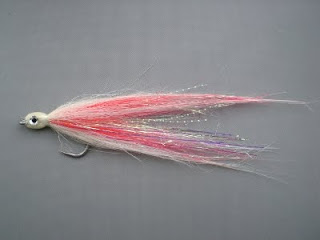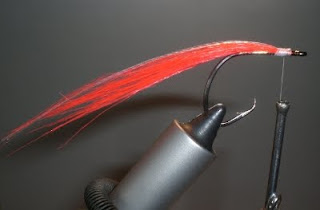
www.adventureflyfishinguk.co.uk
One of the flies that seems to make a regular appearance on the end of my line is the 'Thunder Creek'. By no means a new pattern, the Thunder creek has been around since the 70's and maybe a little earlier than that. Originally tied to entice big river trout over in the States, we often use the same style of fly for our bass and pike fishing at aff-UK. It has also accounted for a good number of decent perch over the years, and will no doubt make a good zander fly. It has also been very popular with some of the saltwater anglers who fish around the Devon and Cornish coast, where we have been busy tying a few for the guys.
The 'Thunder Creek' fly- Pike style.
With the trout season drawing to an end for another year, and with thoughts perhaps turning towards winter predator fly fishing, I thought it would be of interest to show the tying of the fly. I like to carry an assortment of various sizes and coloures, dependant of the species we are looking to catch. For saltwater fly fishing, I tend to use sizes from 6-1, and when fly fishing for pike tie them on larger hooks from size 1-3/0. Nearly all of my flies are tied on Varivas hooks nowadays. They are strong and sharp, and have yet to let me down when there is an angry fish trying to shake it apart.
1. Materials used for the 'Thunder Creek'.
2. Place the hook in the vice and lay on a small bed of thread.

3. Tie in a length or pearl tinsel, (or not). It's one of those extras that can be missed if you want!

4. Touching turns, wrap the tinsel back towards the bend of the hook, and back to the eye and fasten down with a few wraps of thread.This will help to form a reflective under-body, and add durability to the fly. Cover the body in a couple of coats of 'Hard as nails' for extra strength, and to 'tooth-proof' it.

5. Tie in a slim bunch of fibres (colour of your choice), and tie down to the top of the hook shank. As with most of my larger predator flies, I like to use as much synthetic fibre as possible. Unlike the traditional dressing which consisted of bucktail, I have turned to the modern fibres to aid with water-shed, and enable me to tie modern pattens and coloures. One tip when tying in the body fibre, is to wet it prior (bit o spit), to help stroke the fibre into shape and check the taper. Trim the waste ends off.
6. Add a few strands of krystal flash or other eye catching material, and trim off the waste ends.
7. Repeat the same process as pic 6, but using a different colour materials tie one bunch on top of the hook, and one on the underside, making sure the tips are the same length and facing forward. Here you can add some more tinsel to the top of the fly, that will shine through the body once the fly is complete.

8. How the fly looks at this point.
9. Form a dubbed rope of pearl hair or something similar. This will help to do two things. First it will hide any untidy and uneven head problems and also build the head up to a decent size to suit the profile of the fly.

10. When the head had been dubbed, and your happy with the shape, then it is time to separate the top and bottom fibres at the front of the hook. Again moisten the fibres before doing so, to help them fold back easier. Once the top fibres are pulled back, secure with a few turns of thread. Next is to fold the bottom fibres back. This is a little more tricky as they have to be worked either side of the bend to even the under body out. Again, once pulled back secure with a few turns, and bind the head tight. Next is to whip finish the fly (tying the knot over the neck area of the fly).

11. Finish the fly off with a pair of eyes and epoxy the head. I say epoxy, I always use Loon Hard Head for this kind of work. It's as good as epoxy, and a lot less hassle. It is already mixed, you can thin it with water, and it cures in about 20 minuets. Giving time for any bubbles to rise and pop. (The head on the photo is lacking the finishing). When using resin for big heads, its always worth investing in a rotary drier. This helps eliminate any drips, and rounds the head off nicely.

Thunder Creeks are perfect when fish are bait bashing.

They can be fished either single, or as a team.
"I hope this is some use to you, If you decide on trying the thunder creek, it would be good to see a few fish that have been caught on them. Email any pics to us at markbay@hotmail.com and we will stick them in our gallery".
www.adventureflyfishinguk.co.uk
Fly fishing tuition. Guided fly fishing. Fly fishing for pike. Guided river fishing. AAPGAI. Rio Pro Guide. Fly fishing in Devon. Saltwater fly fishing. Mark Bailey. Adventure fly fishing.





These are great tips for catching a trout! These techniques are surely helpful especially to those in the marine paneling industry who are fond of fishing. Thanks for sharing a very informative article.
ReplyDelete